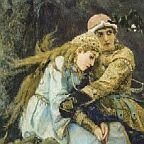Russian Legends, Folk Tales and Fairy Tales
dal 14/12/2007 al 5/4/2008
Segnalato da
14/12/2007
Russian Legends, Folk Tales and Fairy Tales
Groninger Museum, Groningen
The highlights of this exhibition are the many paintings by the nineteenth-century artists Victor Vasnetsov and Nikolas Roerich, and the illustrations by Ivan Bilibin and Elena Polenova.

From 15 December 2007 to 6 April 2008, the Groninger Museum will present the
large-scale exhibition entitled Russian Legends, Folk Tales and Fairy Tales.The
highlights of this exhibition are the many paintings by the nineteenth-century
artists Victor Vasnetsov and Nikolas Roerich, and the illustrations by Ivan Bilibin
and Elena Polenova.
After the successful exhibition Ilya Repin, Russia’s Secret in 2001, Russian
Landscape in 2003, and Working for Diaghilev in 2004, there is yet another important
theme that has remained underexposed in the overwhelming and multi-faceted range of
Russian art from the nineteenth century: Russian Legends, Folk Tales and Fairy
Tales.
Although fairy tales and folk tales had been an integral part of folklore for
hundreds of years, they only became a fully-fledged theme within the visual arts in
the nineteenth century. Interest in Russian legends and folk tales began to flourish
in this period, originating from a yearning to reach back to a tradition that was
able to express the true essence of Russia. This quest for Russian tradition was
unique and led to a very specific style in Russian painting, of which Victor
Vasnetsov was one of the most important representatives.
Toward the end of the 19th century, the paintings by Victor Vasnetsov and the
illustrations by Bilibin – which were created a little later but were
certainly equally renowned – opened up a completely new world. In this
imaginary, magical realm, themes from Russian history, legends and literature were
combined with techniques from national, folkloristic tradition as well as new
developments in the visual arts in the 19th century.
When Russian artists seized upon these themes and opted to represent them on
large-format canvas, they united the reality of the Russian countryside with the
imaginary world of the fairy tale. It is this combination of faithfully reproduced
reality and an imaginative, enchanted situation – painted in a format that was
normally reserved for important themes from history – that ensured that these
paintings left a lasting impression upon the viewer. The struggle between good and
evil, which resounds through most folk tales, also occurs in the paintings.
Nevertheless, these paintings were also occasionally created for completely
different purposes than the literal representation of the narrative. For example,
the painting entitled The Flying Carpet by Victor Vasnetsov was commissioned by
Savva Mamontov, a powerful patron of the arts, to cover the wall of a new railway
station. As such, the large format is immediately explained, but this commission
simultaneously gave a new dimension to the work. The Flying Carpet suddenly became a
symbol for a flight to the new world, future prosperity, and perhaps even freedom of
spirit. The imaginative power of the narrative as an instrument for a social message
ensures that these paintings cannot be viewed solely as belonging to the magical
realm of fantasy. Other important works by Vasnetsov include: Ivan Tsarevitch on the
Grey Wolf and Horseman at the Crossroads. These works are now icons of
nineteenth-century Russian painting.
Nikolas Roerich was primarily interested in Slavonic heroics, Scandinavian sagas,
and religious myths from medieval Russia. In his work, he tried to evoke, in
colourful patterns, a bygone world in which people lived in harmony with one another
and with nature.
Illustrations
This part of the exhibition is closely linked to the literature and the folk tales
themselves. The prints will be an important feature of the exhibition, in view of
the fact that fairy tales, folk tales and legends first entered the visual arts in
the form of illustrations. In this section, Ivan Bilibin plays a major role. He
produced unique and very personal illustrations that can be regarded as highlights
in the history of Russian art, right down to the present day. They transcend the
boundaries of pure illustration. The art of Bilibin and of Vasnetsov displays a
clear mutual kinship.
Elena Polenova was another important illustrator. She studied the sources of the
folk tales in order to gain a better understanding of that world. She also travelled
through the Province of Kostroma in order to record the verbal folklore there.
The association with literature
Before the theme of folk tales and legends had been accepted in the visual arts, it
had already captured a recognized position within literature. Accordingly, the
exhibition will devote attention to the narrative itself, and the part of the tale
that is expressed in the painting will be told.
The author Alexander Pushkin illustrated his own tales in the 1830s, and the tales
of Pushkin remained popular as a literary theme among artists, illustrators and
composers throughout the entire nineteenth century. In this way, folk tales and
legends became a source of inspiration, containing both poetic imagination and
historically authentic information. They led to the generation of detailed
‘literary’ representations.
In contrast to the 20th century and our own age, the fairy tale books of the 19th
century were not intended only for children but also for adults, who were capable of
fully appreciating and understanding the graphic realization of the illustrations
and the pleasantly odd world conceived by the artist.
Catalogue
The exhibition catalogue will cover both the art-historical and the literary
significance of the folk tales within the domain of the visual arts. It will also
explain whether or not, and how, the role of folk tales in Russian society differed
from that in the Western world. The catalogue will be published by NAi Publishers.
The exhibition was made possible by a generous contribution from the Stichting
Fondsbeheer Culturele Relatie-evenementen Gasunie en Gasterra (Foundation of Gasunie
and Gasterra for Culture-related Events).
Groninger Museum
Museumeiland 1- Groningen



